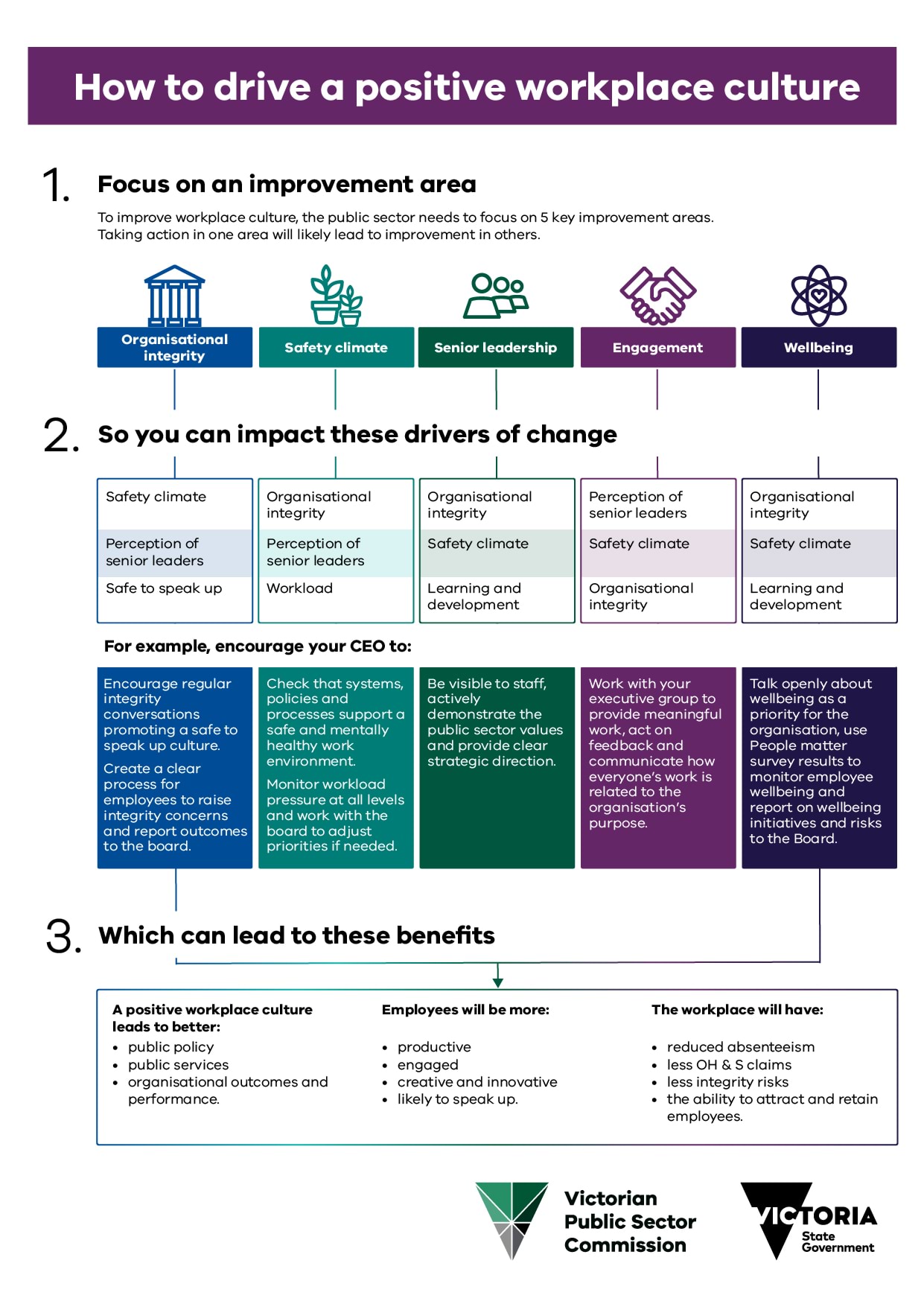Your board’s role
Your board sets the tone from the top of the organisation. You oversee the CEO or equivalent to help drive a positive workplace culture.
This guide explains how to use your organisation’s People matter survey results to monitor and influence a positive culture.
For more information check out resources to support Victorian public sector board directors, chairs and entities and the Victorian Public Sector Commission's guide for establishing portfolio governance arrangements.
Why workplace culture matters
People matter survey results and current research show that a positive workplace culture leads to better public policies, services, organisational outcomes and performance.
Employees who work in a positive environment are more productive, engaged, innovative and likely to speak up. For example, if they experience or witness negative behaviours.
They also take less sick leave and are less likely to report workplace health and safety issues.
Monitoring and shaping workplace culture is an ongoing process. But it’s especially important to focus on improving culture during times of change or uncertainty.
Measuring workplace culture
Each year, employees across the Victorian public sector do the People matter survey.
The results help organisations understand how employees feel about their organisation and their work.
The Victorian Public Sector Commission analysed answers to the 2023 People matter survey questions to find out what improves workplace culture.
What the results say about workplace culture
To improve workplace culture, the public sector needs to focus on 5 key improvement areas and survey statements:
How to drive a positive workplace culture
Knowing what drives a positive workplace culture will help you find ways to improve it.
This section explains the key improvement areas and provides tips and other research.
Organisational integrity
We need the community to have trust in how we work and what we do.
Organisations show integrity by:
- treating employees and the community fairly and with respect
- implementing fair and equitable policies and services
- providing full and frank advice to government.
Tips to improve organisational integrity
Boards should monitor integrity(opens in a new window) in their organisation and work with their CEO, to:
- support and encourage regular integrity conversations at Board meetings and throughout the organisation
- actively monitor the organisation’s integrity performance and risks
- implement clear and fair internal policies and procedures in line with public sector values
- ensure employees understand their integrity obligations(opens in a new window). For example, managing conflicts of interest, declaring gifts, benefits and hospitality.
- create a safe work environment for employees to report integrity concerns and address negative behaviours
- implement fair recruitment practices based on merit and equity.
Safety climate
Safety climate refers to how physically and psychologically safe employees feel at work.
Under the Occupational Health and Safety Act 2004, employers have obligations and duties to create a safe work environment.
When employees feel safe at work are more likely to:
- be their authentic self at work
- feel confident to speak up, share and ask questions
- report and respond to negative behaviour
- acknowledge mistakes and learn from them.
Creating a safe and mentally healthy workplace culture starts with senior leaders and managers.
Leaders can take practical steps to influence workplace culture. They lead by example and demonstrate behaviours and attitudes they want to see in their employees.
Evidence suggests that organisations that report a higher percentage of employees who feel their opinions matter at work had a reduction in turnover and safety incidents and an increase in productivity.
Tips to improve your safety climate
Boards should monitor the safety climate in their organisation and encourage their CEO to:
- check that systems, policies and processes support a safe and mentally healthy work environment
- implement mental health and wellbeing strategies that align with Victorian public sector occupational health and safety guidance, policies and frameworks(opens in a new window)
- implement processes and procedures to identity, prevent and manage psychosocial risks
- raise awareness, share resources and educate employees about psychological safety
- implement a clear process for reporting and addressing negative behaviours
- respond early to reported issues using effective tools.
Senior Leadership
A strong workplace culture is built on leaders who model the public sector values and provide clear strategic direction.
Supportive leaders give employees clarity, appreciation, feedback and coaching.
This can make employees feel more engaged and connected to their work and organisation.
Tips for improving senior leadership
Boards should monitor the senior leadership in their organisation and encourage their CEO to lead by example and:
- model integrity, including remaining apolitical and providing frank and impartial advice
- implement organisational values and make these meaningful for employees
- provide clear strategic direction and set long-term organisational goals
- regularly engage with employees
- take leave and other entitlements
- provide opportunities for feedback and advice from the bottom up.
Engagement
Improving engagement helps organisations attract new talent, retain their employees and improve employee wellbeing.
Engagement and wellbeing are linked and affect motivation, productivity, retention and job satisfaction.
Engaged employees are much more likely than disengaged employees to recommend their organisation as a great place to work.
Tips for improving engagement
Boards should monitor engagement in their organisation and encourage their CEO, to:
- implement strategies that align with the Victorian Public Sector Commission’s drivers of wellbeing and engagement insights(opens in a new window)
- empower managers to identify and provide meaningful work and growth opportunities
- empower employees to have control over their work and how they do it
- create an environment where employees feel safe to express their ideas, concerns and give feedback
- communicate how you’re addressing feedback and make continuous improvements.
Wellbeing
Safe and healthy work environments benefit employees, employers and the Victorian community.
Research suggests that employees who report high levels of wellbeing are more likely to:
- be more engaged, creative and productive
- provide better customer service
- report more positive interactions with their managers
- be more confident to speak up
- be more satisfied with their job, career development and work-life balance.
Negative behaviours such as sexual harassment and bullying have an impact on employee wellbeing. Organisations need to implement clear reporting processes and respond appropriately.
Tips for improving wellbeing
Boards should monitor employee wellbeing in their organisation and encourage their CEO, to:
- establish or promote wellbeing measures and monitor and discuss as a board priority
- implement strategies that align with the Victorian Public Sector Commission’s drivers of wellbeing and engagement insights
- model respect and promote a culture that prioritises wellbeing
- provide opportunities to have honest conversations with employees at all levels
- create an environment where employees feel safe to discuss their wellbeing and ask for help
- acknowledge the impact of external stresses such as climate emergencies, major events or organisational change.
Infographic on how to drive a positive workplace culture
This infographic shows a high-level view of:
- the improvement areas
- what drives change
- potential benefits.
You can download a copy to help you start conversations with your board and CEO.

Download a pdf version of the page
Updated
